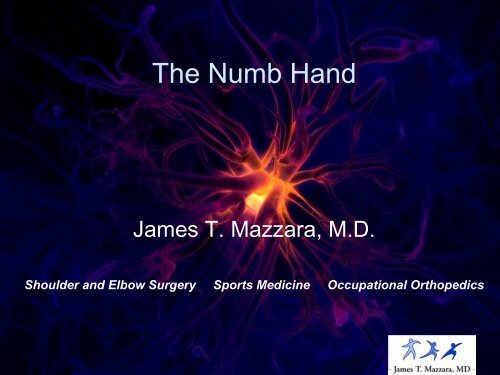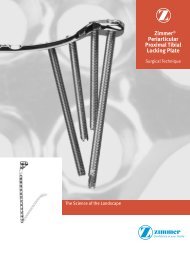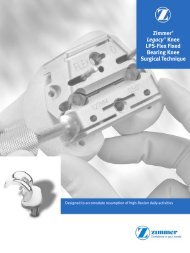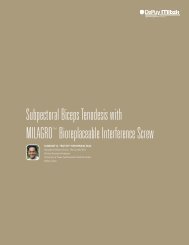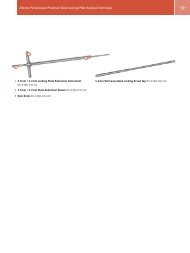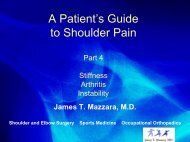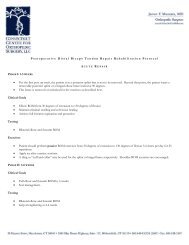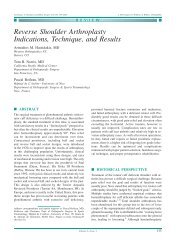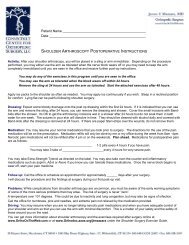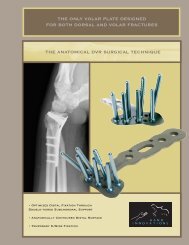The Numb Hand (pdf)
The Numb Hand (pdf)
The Numb Hand (pdf)
Create successful ePaper yourself
Turn your PDF publications into a flip-book with our unique Google optimized e-Paper software.
<strong>The</strong> <strong>Numb</strong> <strong>Hand</strong><br />
James T. Mazzara, M.D.<br />
Shoulder and Elbow Surgery Sports Medicine Occupational Orthopedics
Patient Education Disclaimer<br />
This presentation describes information to educate consumers on<br />
various health topics. It is NOT intended to provide instruction on<br />
medical diagnosis or treatment. <strong>The</strong> information contained in this<br />
handout is compiled from a variety of sources. It may not be<br />
complete or timely. It does not cover all diseases, physical<br />
conditions, ailments or treatments. You should NOT rely on this<br />
information to determine a diagnosis or course of treatment. <strong>The</strong><br />
information should NOT be used in place of an individual<br />
consultation, examination, visit or call with your physician or other<br />
qualified health care provider. You should never disregard the<br />
advice of your physician or other qualified health care provider<br />
because of any information you read in this presentation or on any<br />
websites you visit as a result of this presentation. If you have any<br />
health care questions, please consult your physician or other<br />
qualified health care provider promptly. Always consult your<br />
physician or other qualified health provider before you begin any<br />
new treatment, diet or fitness program.
<strong>The</strong> Nerve<br />
• 3 Types of nerves<br />
– Motor<br />
• Muscle control<br />
• Go from brain to muscles<br />
–Sensory<br />
• Sensation<br />
• Go from body to brain<br />
– Autonomic<br />
• Involuntary<br />
• Heart rate, blood pressure,<br />
digestion, sweating
Idiopathic Nerve Damage<br />
• Unknown cause<br />
• Older than 60<br />
• <strong>Numb</strong>ness, tingling and pain<br />
• Unsteady gait<br />
• Weakness or cramps
Toxic Nerve Damage<br />
• Lead, mercury, arsenic, thallium<br />
• Anticonvulsants<br />
• Cancer medications<br />
• Heart or blood pressure medications<br />
• Infection fighting drugs<br />
• Skin condition treatment drugs
Alcohol-Related Nerve Damage<br />
• Abnormal sensations<br />
– Pain<br />
• Feels like "pins and needles"<br />
– <strong>Numb</strong>ness<br />
– Muscle weakness, cramps, or aches<br />
– Muscle spasms / contractions<br />
– Tingling<br />
• Constipation / Diarrhea<br />
• Incontinence (leaking urine) or difficulty with urination<br />
• Impotence in men<br />
• Nausea / vomiting
Inflammatory Nerve Damage<br />
Infectious (with a specific casual agent identified)<br />
• Lyme disease<br />
• HIV / AIDS<br />
• Herpes Zoster (Shingles)<br />
• Hepatitis B and C<br />
Autoimmune or possibly infectious (but with no specific<br />
causal infectious agent identified)<br />
• Sarcoidosis<br />
• Polyarteritis Nodosa (PAN)<br />
• Rheumatoid Arthritis<br />
• Systemic Lupus Erythematosus (Lupus)<br />
• Sjögren's Syndrome
Anatomy<br />
<strong>The</strong> nerves exit from the<br />
cervical spine through<br />
bone tunnels called<br />
foramen. <strong>The</strong>y then pass<br />
beneath the clavicle (collar<br />
bone) as they enter the<br />
arm where they become<br />
individually named nerves.<br />
<strong>The</strong> network of nerves<br />
between the cervical spine<br />
and the arm is called the<br />
brachial plexus.
Anatomy<br />
<strong>The</strong> nerves then pass down the arm and innervate different<br />
groups of muscles and give sensation to different parts of the<br />
arm and hand.
Cervical Nerve Compression<br />
Each nerve<br />
provides<br />
sensation to a<br />
specific area of<br />
the arm and<br />
hand. Each<br />
nerve root from<br />
the cervical<br />
spinal cord<br />
supplies its own<br />
particular nerve<br />
as seen here.
Sensory Nerve Anatomy<br />
This is the anatomy of<br />
the sensory nerves to<br />
the arm and hand.
Types of Nerve Injury<br />
• Neuropraxia<br />
– Slow nerve conduction with and intact nerve<br />
– Damage is reversible
Types of Nerve Injury<br />
• Axonotmesis<br />
– Severe injury with<br />
nerve degeneration<br />
– Intact nerve fibers<br />
– Recovery is possible<br />
and depends on the<br />
distance of nerve<br />
lesion to the site of<br />
innervation<br />
Muscle<br />
atrophy
Types of Nerve Injury<br />
• Neurotmesis<br />
– Complete<br />
disruption of the<br />
nerve<br />
– Full recovery is<br />
unlikely
Our Focus<br />
• Nerve compression conditions of the arm<br />
and hand<br />
– Carpal Tunnel Syndrome<br />
• Anterior interosseus nerve syndrome<br />
• Pronator Syndrome<br />
– Cubital Tunnel Syndrome<br />
– Radial Tunnel Syndrome<br />
• Posterior interosseus nerve syndrome<br />
• Wartenberg’s syndrome
Nerve Injuries of the Arm<br />
• More common in younger industrial<br />
workers<br />
– 1994: 93,000 cases of repetitive<br />
use disorders<br />
– 41% of these were carpal tunnel syndrome<br />
• Overall 1 million adults/year require<br />
treatment for CTS
Epidemiology<br />
Carpal Tunnel<br />
Syndrome<br />
Mean age @<br />
diagnosis<br />
Distribution<br />
Males 50 years 22%<br />
Females 51 years 78%
Compressive Neuropathy<br />
• Associated<br />
symptoms<br />
– Poorly characterized<br />
& difficult to label<br />
tendon and muscle<br />
symptoms
Contributing Factors<br />
• Work place<br />
– Repetitiveness<br />
–Force<br />
– Mechanical stress<br />
–Posture<br />
–Vibration<br />
–Temperature
Contributing Factors<br />
• Carpal tunnel<br />
epidemiology studies<br />
– Higher correlation with<br />
health habits & lifestyle<br />
• Obesity<br />
• Tobacco use<br />
• Caffeine
Contributing Factors<br />
• Definitive risk factors<br />
– Female<br />
– Pregnancy<br />
– Diabetes<br />
– Hypothyroidism<br />
– Rheumatoid arthritis
Contributing Factors<br />
• Study of idiopathic carpal tunnel syndrome<br />
– Analyzed the synovium of patients with CTS<br />
• Findings suggested that repeated<br />
episodes of ischemia and reperfusion may<br />
lead to the development of CTS<br />
• Freeland, Microsurgery, 22, 2003
Contributing Factors<br />
• Occupational risk factors alone do not<br />
explain the occurrence of carpal tunnel<br />
syndrome in the workforce<br />
• Carpal tunnel syndrome is due to multiple<br />
overlapping factors
Contributing Factors<br />
• Nerve traction injuries<br />
– Compression at one site may tether the nerve<br />
– Leads to restricted nerve mobility with traction<br />
and stretching of the nerve
Contributing Factors<br />
•Nerve<br />
compression<br />
impairs<br />
microcirculation<br />
Hyperemia (increased<br />
circulation) after nerve release<br />
of ulnar verve at elbow
Systemic Factors<br />
• Certain conditions lower the threshold for<br />
compressive neuropathy<br />
• This may lead to involvement of both sides<br />
when nerve compression syndromes occur<br />
• For example<br />
– Obesity<br />
– Diabetes<br />
– Alcoholism<br />
– Hypothyroidism<br />
– Industrial solvent exposure<br />
– Aging
•Early<br />
Phases of Compressive<br />
Neuropathy<br />
• Intermediate<br />
• Late / Advanced
Early Phase<br />
• Low grade compression<br />
• Symptoms come and go<br />
• Conservative treatment<br />
is effective<br />
– NSAIDS<br />
– Steroid injections<br />
– Splints
Intermediate Phase<br />
• Intraneural<br />
circulation is<br />
persistently<br />
compromised<br />
• Constant<br />
paresthesias and<br />
numbness<br />
• Respond best to<br />
nerve<br />
decompression<br />
Hyperemia after carpal<br />
tunnel release
Advanced Phase<br />
• Continuous edema and<br />
compression induce<br />
intraneural fibrosis<br />
• Irreversible damage with<br />
some permanent loss of<br />
sensation and motor<br />
function<br />
• Surgery stops the<br />
continuing nerve damage<br />
but does not assure full<br />
recovery<br />
– Permanent nerve damage<br />
already exists before<br />
surgery<br />
Atrophy (loss of<br />
muscle mass,<br />
tone and function)<br />
due to prolonged,<br />
advanced nerve<br />
compression
Double Crush Phenomenon<br />
• 2 separate points of nerve compression<br />
– Compression proximally lowers the threshold<br />
for compression neuropathy at a distal point<br />
• Interrupted transport of enzymes and<br />
neurotransmitters along the axon
Double Crush Phenomenon<br />
• Surgical decompression may<br />
lead to incomplete symptom<br />
relief<br />
– A nerve may be compressed in<br />
2 locations: e.g., the neck and<br />
the wrist<br />
– Release of the wrist<br />
compression (carpal tunnel)<br />
may or may not improve<br />
symptoms but should be<br />
considered to avoid further<br />
damage to the nerve<br />
– Cervical radiculopathy & CTS<br />
• Still consider CT release<br />
• Advise the patient
Clinical Presentation<br />
• Dynamic<br />
– Symptoms are<br />
activity specific<br />
– Exertional<br />
• Insidious<br />
– Gradual onset<br />
– Unrelated to activity<br />
– Worse at night
Carpal Tunnel Syndrome<br />
• Anatomic<br />
predisposing factors<br />
– Decreased size of<br />
carpal tunnel<br />
• Bony abnormalities<br />
• Thickened transverse<br />
carpal ligament
Carpal Tunnel Syndrome<br />
• Anatomic<br />
predisposing factors<br />
– Increased contents of<br />
carpal tunnel<br />
• Ganglion cysts<br />
• Neuroma, lipoma,<br />
myeloma, hypertrophic<br />
synovium, fracture<br />
callus, osteophytes,<br />
hematoma
Carpal Tunnel Syndrome<br />
• Neuropathic conditions<br />
– Diabetes<br />
– Alcoholism<br />
– Thyroid dysfunction<br />
– Double crush<br />
phenomenon<br />
• Proximal compression of<br />
median nerve<br />
A patient with a history of cervical nerve root<br />
injury
Carpal Tunnel Syndrome<br />
• Inflammatory<br />
predisposing<br />
conditions<br />
– Tenosynovitis<br />
– Rheumatoid arthritis<br />
– Infection<br />
– Gout
Carpal Tunnel Syndrome<br />
• Alterations in fluid<br />
balance<br />
– Pregnancy<br />
– Long-term<br />
hemodialysis<br />
– Raynaud’s disease<br />
– Obesity
Carpal Tunnel Syndrome<br />
• Position and use of wrist<br />
– Repetitive flexion /<br />
extension<br />
– Repetitive forceful<br />
squeezing and releasing or<br />
torsion of a tool<br />
– Finger motion with wrist<br />
extension<br />
• Typists, musicians<br />
– Vibration exposure
Carpal Tunnel Syndrome<br />
• Weightbearing with wrist extension<br />
– Paraplegia<br />
– Long-distance cycling
Carpal Tunnel Syndrome<br />
• Immobilization with<br />
the wrist flexed<br />
– Wrist fractures can<br />
cause scarring,<br />
swelling and crowding<br />
of the carpal tunnel<br />
– Awkward sleep<br />
position
Carpal Tunnel Syndrome<br />
• Pain & paresthesias<br />
palmar radial hand<br />
• Symptoms worse at night<br />
• Symptoms worse with<br />
repetitive forceful use of<br />
hands
Carpal Tunnel Syndrome<br />
• Phalen’s test<br />
Diagnostic Tests<br />
– <strong>Numb</strong>ness / tingling<br />
< 60 sec<br />
– Sensitivity 0.75<br />
– Specificity 0.47
Carpal Tunnel Syndrome<br />
• Percussion test<br />
(Tinel’s sign)<br />
Diagnostic Tests<br />
– Tingling at site of<br />
nerve tapping<br />
– Sensitivity 0.60<br />
– Specificity 0.67
Carpal Tunnel Syndrome<br />
• Compression test<br />
Diagnostic Tests<br />
– Paresthesias < 30 sec<br />
– Sensitivity 0.87<br />
– Specificity 0.90
Carpal Tunnel Syndrome<br />
• <strong>Hand</strong> diagram<br />
Diagnostic Tests<br />
– Appropriate markings<br />
on radial digits not on<br />
palm<br />
– Sensitivity 0.96<br />
– Specificity 0.73<br />
– Value of a negative<br />
test 0.91
Carpal Tunnel Syndrome<br />
• 2-point discrimination<br />
Diagnostic Tests<br />
– Unable to discriminate<br />
6mm<br />
– Advanced nerve<br />
dysfunction
Carpal Tunnel Syndrome<br />
• Vibrometry<br />
Diagnostic Tests<br />
– Note asymmetry with<br />
contralateral hand or<br />
radial versus ulnar<br />
– Sensitivity 0.87
Carpal Tunnel Syndrome<br />
• Semmes-Weinstein<br />
monofilaments<br />
Diagnostic Tests<br />
– Positive if unable to<br />
feel filaments less than<br />
2.83<br />
– Sensitivity 0.83
Carpal Tunnel Syndrome<br />
• X-rays are valuable in<br />
many cases<br />
– Trauma<br />
Diagnostic Tests<br />
– Rheumatoid disease<br />
– Basal joint arthritis
Carpal Tunnel Syndrome<br />
• Nerve conduction<br />
testing<br />
• Sensory testing<br />
– Positive if latency<br />
>3.5mm/sec or if<br />
0.5mm/sec > other<br />
hand<br />
Diagnostic Tests
• EMG<br />
Carpal Tunnel Syndrome<br />
• Tests the motor part<br />
of the nerve<br />
Diagnostic Tests<br />
– Positive if latency >4.5<br />
mm/sec or if 1.0<br />
mm/sec > other hand
Carpal Tunnel Syndrome<br />
• EMG<br />
– Tests for denervation<br />
of thenar muscles<br />
Diagnostic Tests<br />
– Very advanced nerve<br />
damage<br />
– Objective confirmation
Carpal Tunnel Syndrome<br />
• Chest x-ray<br />
– Smokers<br />
– Ulnar nerve<br />
symptoms<br />
– Shoulder pain<br />
• MRI<br />
– Evaluate nerve<br />
compression in<br />
forearm<br />
Diagnostic Tests<br />
Ganglion cyst<br />
compressing carpal<br />
tunnel
Carpal Tunnel Syndrome<br />
• Most sensitive<br />
Diagnostic Tests<br />
– Semmes-Weinstein<br />
filament<br />
– Vibrometry<br />
• Threshold tests<br />
A simple way to test light<br />
touch sensitivity
Carpal Tunnel Syndrome<br />
• Consider overall health<br />
• If both hands are involved<br />
– Consider systemic or metabolic causes<br />
• Consider proximal compression<br />
– Cervical radiculopathy<br />
– Pronator syndrome
Carpal Tunnel Syndrome<br />
• Conservative<br />
treatment<br />
– Nighttime splinting in<br />
neutral<br />
– NSAIDs to reduce<br />
synovitis<br />
– Manage contributing<br />
systemic causes
Carpal Tunnel Syndrome<br />
• Corticosteroid<br />
injections<br />
– Transient relief in 80%<br />
– Only 22% symptom<br />
free at 1 year
Carpal Tunnel Syndrome<br />
• Injections are an excellent predictor of a<br />
patients response to surgery<br />
• Excellent prognostic tool<br />
– 87% with a positive response to injection had<br />
successful surgery<br />
– 54% with a negative response to injection had<br />
successful surgery<br />
• Edgell J <strong>Hand</strong> Surg {Am} 28, 2003
Carpal Tunnel Syndrome<br />
• Corticosteroid<br />
injections<br />
– Most effective if<br />
symptomatic for <<br />
1 year<br />
– Diffuse and<br />
intermittent<br />
numbness<br />
– Normal 2-point<br />
discrimination<br />
– No weakness or<br />
thenar atrophy<br />
– EMG reveals no<br />
denervation<br />
– 1-2 millisecond<br />
prolongation on<br />
NCS<br />
– 40% of this group<br />
symptom free at 1<br />
year
Carpal Tunnel Syndrome<br />
• Alternative treatments<br />
– Vitamin B6 (Pyridoxine)<br />
– Cold Laser<br />
– Acupuncture<br />
–TENS<br />
– Chiropractic manipulations<br />
• <strong>The</strong>re is no scientific evidence that any of<br />
these treatments are effective
Carpal Tunnel Release<br />
• Indicated for failed conservative treatment<br />
• Earlier surgery yields better results<br />
– CTR within 3 years of symptom onset yields<br />
better results
Carpal Tunnel Release<br />
• Advanced cases<br />
– CTR may only<br />
prevent progression<br />
– CTR may not lead to<br />
improvement
Carpal Tunnel Release<br />
• Patients with<br />
intermittent pre-op<br />
symptoms obtain<br />
better sensory<br />
recovery than<br />
patients with<br />
constant symptoms
Carpal Tunnel Release<br />
• Endoscopic<br />
– Minimal effect on<br />
post-op recovery<br />
– Poor visualization of<br />
nerve<br />
– Increased risk of NV<br />
injury
Carpal Tunnel Release<br />
• Randomized trial comparing endoscopic to<br />
open CTR<br />
• Endoscopic group<br />
– Less pain & more grip strength @ 1 and 6 w<br />
– No different from open group @ 12 w<br />
– Less satisfied than open group<br />
• <strong>The</strong> re-operation rate in the endoscopic group<br />
was 5% v. 0% in the open CTR group<br />
– Macdermid J <strong>Hand</strong> Surg {Am} 28, 2003
Carpal Tunnel Release<br />
• Mini-open<br />
– Good visualization of<br />
nerve & ligament<br />
– Fewer complications<br />
– Re-operations are rare<br />
– Grip strength recovery<br />
in 3 months<br />
– Pinch strength<br />
recovers in 6w<br />
Median Nerve<br />
Transverse<br />
Carpal<br />
Ligament
Carpal Tunnel Release<br />
Complications<br />
• Transient<br />
• Permanent<br />
– Infection<br />
– Nerve injury<br />
– Sensitivity<br />
– Pillar pain<br />
• Anatomic variations<br />
involving motor<br />
branches
Carpal Tunnel Syndrome<br />
• May be associated<br />
with ulnar neuropathy<br />
@ Guyon’s canal<br />
– Responds to CTR<br />
alone
Carpal Tunnel Release<br />
• Post-op<br />
– Bulky dressing for<br />
48 hours<br />
– Remove dressing<br />
and use hand as<br />
tolerated<br />
– Keep wound clean,<br />
dry and covered<br />
with a Band-aid
Carpal Tunnel Release<br />
• Post op course with the<br />
open CT release<br />
– Progressive activities as<br />
tolerated at 48 hours<br />
– Return to work 21 days<br />
without restrictions
Carpal Tunnel Release<br />
• <strong>The</strong> incision @ 3 weeks<br />
– <strong>The</strong>re may be some<br />
wound sensitivity at 6-12<br />
weeks but this resolves in<br />
time
Pronator Syndrome<br />
• Median nerve<br />
entrapment @ elbow
Pronator Syndrome<br />
• Symptoms<br />
– Weakness and<br />
aching of the thumb<br />
muscles<br />
– <strong>Numb</strong>ness in the<br />
thumb, index &<br />
middle finger<br />
– <strong>Numb</strong>ness in the<br />
area of the palmar<br />
cutaneous nerve<br />
• mid palm and thenar<br />
eminence
Pronator Syndrome<br />
• Diagnostic findings<br />
– Pain in upper forearm<br />
– Positive Tinel’s sign in forearm<br />
– No finger numbness with wrist flexion<br />
– No symptoms at night<br />
• Unlike CTS
Pronator Syndrome<br />
• Compression @<br />
bicipital aponeurosis<br />
Compression Sites<br />
– Resisted elbow flexion<br />
with forearm<br />
supination
• Compression @<br />
pronator muscle<br />
Pronator Syndrome<br />
Compression Sites<br />
– Resisted forearm<br />
pronation with elbow<br />
extended
• Compression @<br />
origin of FDS<br />
Pronator Syndrome<br />
Compression Sites<br />
– Resisted isolated<br />
flexion of the PIP of<br />
middle finger
Pronator Syndrome<br />
• Nerve conduction tests<br />
–Nothelpful<br />
– 20-30% of patients with CTS may have<br />
conduction delays in forearm
Anterior Interosseous Nerve<br />
• Median nerve<br />
compression in the<br />
forearm<br />
– Motor deficit<br />
• Weakness of the long<br />
flexors of the thumb<br />
and index finger<br />
– No sensory deficit<br />
Syndrome
Anterior Interosseous Nerve<br />
• Examination<br />
– Precision tip to tip<br />
pinch<br />
Syndrome<br />
• “A OK sign”<br />
• Pinch (thumb and<br />
index finger)<br />
weakness
Anterior Interosseous Nerve<br />
• Spontaneous onset<br />
Syndrome<br />
• EMG-NCS is helpful
Anterior Interosseous Nerve<br />
• Nonoperative<br />
Treatment<br />
– Observation<br />
– Splinting in elbow<br />
flexion<br />
– Surgery if not<br />
improved in 8-12<br />
weeks<br />
Syndrome
Anterior Interosseous Nerve<br />
Syndrome<br />
• Surgical decompression of all potential<br />
sites of compression<br />
• May take up to 6 months to improve
Cubital Tunnel Syndrome<br />
• Ulnar nerve<br />
compression at the<br />
elbow<br />
– “<strong>The</strong> Funny Bone”
Cubital Tunnel Syndrome<br />
• Sources of<br />
compression<br />
– fascial bands<br />
– exuberant synovium<br />
– tumors<br />
– ganglions<br />
– anconeus<br />
epitrochlearis<br />
– bone spurs
Cubital Tunnel Syndrome<br />
• Symptoms<br />
– <strong>Numb</strong>ness along the<br />
little finger and ulnar ½<br />
ring finger<br />
– Weakness of grip &<br />
torque
Cubital Tunnel Syndrome<br />
• Pain medial elbow<br />
• Tinel’s sign @<br />
cubital tunnel<br />
• Symptoms worse<br />
with elbow flexion
Cubital Tunnel Syndrome<br />
• Pain and numbness<br />
on dorsal and volar<br />
ulnar hand<br />
• Weakness ring<br />
& little finger flexors
Cubital Tunnel Syndrome<br />
• Froment’s sign<br />
– Weak intrinsic<br />
muscles of the hand<br />
– Flexor pollicis<br />
longus (flexes the<br />
tip of the thumb)<br />
compensates for<br />
paralyzed thumb<br />
adductor
Cubital Tunnel Syndrome<br />
• Intrinsic muscle<br />
weakness<br />
– Unable to adduct little<br />
and ring fingers due to<br />
advanced cubital tunnel<br />
syndrome<br />
Intrinsic<br />
muscles<br />
innervated<br />
by ulnar<br />
nerve
Cubital Tunnel Syndrome<br />
• Jeanne’s sign<br />
– Compensatory<br />
hyperextension of the<br />
thumb MP joint
Cubital Tunnel Syndrome<br />
• Thumb adductor<br />
weakness<br />
• Severe atrophy<br />
– Muscle wasting
Cubital Tunnel Syndrome<br />
• Pollock’s test<br />
– Weakness of the<br />
flexor strength of<br />
the ring and little<br />
fingers
Cubital Tunnel Syndrome<br />
• Examine cervical spine<br />
• Consider thoracic outlet syndrome<br />
• Assess elbow for arthritis<br />
• Check for ulnar nerve subluxation<br />
(snapping)
Cubital Tunnel Syndrome<br />
• Tinel’s sign @ cubital<br />
tunnel<br />
• Elbow flexion test<br />
(
Cubital Tunnel Syndrome<br />
• Ulnar nerve pressure<br />
test<br />
– Direct pressure<br />
– Elbow 20 o<br />
– Forearm supinated<br />
– Positive if < 60 seconds
Cubital Tunnel Syndrome<br />
• Sensory exam<br />
– <strong>Numb</strong>ness on all<br />
surfaces of little finger<br />
– S-W monofilament test
Cubital Tunnel Syndrome<br />
• Nonoperative<br />
treatment<br />
– Activity<br />
modification<br />
– Don’t lean on the<br />
elbow<br />
– NSAIDs<br />
– Night-time<br />
extension<br />
splints
Cubital Tunnel Syndrome<br />
• Surgical options<br />
– Simple decompression<br />
– Medial epicondylectomy<br />
– Submuscular transposition<br />
– Subcutaneous transposition
Cubital Tunnel Syndrome<br />
• Medial Epicondylectomy<br />
<strong>Hand</strong><br />
Medial<br />
epicondyle
Cubital Tunnel Syndrome<br />
• Medial Epicondylectomy<br />
<strong>Hand</strong><br />
Medial<br />
epicondyle<br />
Ulnar nerve<br />
compression<br />
after release<br />
of Osborne’s<br />
ligament
Cubital Tunnel Syndrome<br />
• Medial Epicondylectomy<br />
Medial<br />
epicondyle<br />
removed<br />
Flexorpronator<br />
attachment<br />
released<br />
Ulnar<br />
nerve<br />
Elbow @ 90 degrees flexion
Cubital Tunnel Syndrome<br />
• Medial Epicondylectomy<br />
Medial<br />
epicondyle<br />
removed<br />
Relaxed<br />
ulnar<br />
nerve<br />
Flexorpronator<br />
attachment<br />
released<br />
<strong>Hand</strong><br />
Elbow @ 90 degrees flexion
Cubital Tunnel Syndrome<br />
• Medial Epicondylectomy<br />
Ulnar<br />
nerve<br />
relaxed<br />
Flexorpronator<br />
mass<br />
reattached<br />
to medial<br />
epicondyle<br />
<strong>Hand</strong><br />
Elbow flexed 90 degrees
Cubital Tunnel Syndrome<br />
• Medial Epicondylectomy<br />
Flexorpronator<br />
mass<br />
reattached<br />
to medial<br />
epicondyle<br />
Ulnar nerve<br />
relaxed<br />
<strong>Hand</strong><br />
Elbow flexed 90 degrees
Cubital Tunnel Syndrome<br />
• Submuscular Transposition<br />
<strong>Hand</strong>
Cubital Tunnel Syndrome<br />
• 88% Good-excellent results<br />
• 8% failure or recurrence<br />
• Compared to 25 – 40% other techniques<br />
• This is the procedure I have performed since 2003<br />
JBJS July, 2003
Cubital Tunnel Syndrome<br />
• Submuscular Transposition<br />
Decompressed<br />
ulnar nerve<br />
Preserved<br />
sensory<br />
nerves<br />
<strong>Hand</strong>
Cubital Tunnel Syndrome<br />
• Submuscular Transposition<br />
Preserved<br />
sensory<br />
nerves<br />
A<br />
B<br />
Decompressed<br />
ulnar nerve<br />
<strong>Hand</strong>
Cubital Tunnel Syndrome<br />
• Submuscular Transposition<br />
<strong>Hand</strong><br />
B<br />
A<br />
Preserved<br />
sensory<br />
nerves<br />
Transposed<br />
ulnar nerve
Cubital Tunnel Syndrome<br />
• Subcutaneous Transposition
Cubital Tunnel Syndrome<br />
• Surgical results<br />
– 80-90% good results<br />
– Functional recovery 6 months<br />
• Moderate – severe compression<br />
– Recurrence rates or poor results in 25-30%<br />
• In revision ulnar nerve translocation the ulnar<br />
nerve is moved from its previous subcutaneous<br />
position and placed in a submuscular position.<br />
– Studies have shown that placing the nerve in a<br />
submuscular position (with tendon z-plasty) is highly<br />
successful and reduces the rate of recurrence<br />
significantly
Ulnar Tunnel Syndrome<br />
• Ulnar nerve<br />
compression in<br />
Guyon’s canal<br />
• Symptoms depend on<br />
site of compression<br />
– Motor<br />
–Sensory<br />
–Mixed
Ulnar Tunnel Syndrome<br />
• Causes of compression<br />
– Ganglion cysts<br />
– Synovial inflammation<br />
– Fractures of hook of<br />
hamate<br />
– Ulnar artery thrombosis<br />
– Anomalous muscle<br />
– Palmaris brevis<br />
hypertrophy
Ulnar Tunnel Syndrome<br />
• Evaluation<br />
– CT scan for hook<br />
of hamate fracture<br />
– MRI for ganglion<br />
cyst<br />
– Doppler ultrasound<br />
for ulnar artery<br />
thrombosis
Ulnar Tunnel Syndrome<br />
• Treatment<br />
– Nonoperative<br />
• Splints<br />
• NSAIDs<br />
– Operative<br />
• Treat underlying<br />
cause (cyst,<br />
fracture)<br />
•Nerve<br />
decompression
Radial Nerve<br />
• Compression above the elbow<br />
• Posterior interosseous nerve syndrome<br />
• Radial tunnel syndrome<br />
• Wartenberg’s syndrome
Radial Nerve<br />
• Compression above the<br />
elbow<br />
–Rare<br />
– Fibrous arch of lateral head of<br />
triceps<br />
– Weakness of wrist extensors<br />
– Sensory changes on top<br />
forearm up to the thumb
Radial Nerve<br />
• May be related to<br />
humeral fracture<br />
callus<br />
• EMG-NCS confirms<br />
the diagnosis<br />
• Surgical<br />
decompression if not<br />
improved in 3 months
Posterior Interosseous Nerve<br />
• Motor portion of radial<br />
nerve compressed in<br />
proximal forearm<br />
• Motor only, no<br />
sensory function<br />
• Innervates wrist and<br />
finger extensors<br />
(PIN) Syndrome
Posterior Interosseous Nerve<br />
• Gradual onset<br />
(PIN) Syndrome<br />
• Subtle loss of<br />
strength with radial<br />
deviation in wrist<br />
extension<br />
– ECRL (the long wrist<br />
extensor muscle) still<br />
functional
Posterior Interosseous Nerve<br />
• EMG: diagnostic<br />
• X-rays: evaluate for<br />
radial head<br />
– Fractures<br />
–Arthritis<br />
– Dislocations<br />
• MRI: ganglions cysts,<br />
lipomas<br />
(PIN) Syndrome
Posterior Interosseous Nerve<br />
• Compression sites<br />
(PIN) Syndrome<br />
– Thick fascia @ the<br />
front of the elbow<br />
joint (radiocapitellar<br />
joint)<br />
– Recurrent radial<br />
artery branches
Posterior Interosseous Nerve<br />
• Compression<br />
sites<br />
– Fibrous edge<br />
of ECRB (wrist<br />
extensor) muscle<br />
(PIN) Syndrome<br />
– Arcade of Frohse<br />
@ proximal edge<br />
of supinator<br />
muscle
Posterior Interosseous Nerve<br />
(PIN) Syndrome<br />
• Treatment<br />
– Avoid aggravating activities<br />
–NSAIDs<br />
– Surgical release if not improved in 4-12 weeks<br />
– Strength recovery may take 18 months<br />
– 85% good – excellent results
Radial Tunnel Syndrome<br />
• Pain<br />
• No motor or sensory deficits<br />
• Same nerve and compression sites as PIN<br />
syndrome<br />
• Work-related<br />
– Associated with forceful elbow extension or<br />
forearm rotation
Radial Tunnel Syndrome<br />
• Symptoms<br />
– Deep ache on lateral<br />
elbow & forearm<br />
– Night pain<br />
– Confused with lateral<br />
epicondylitis<br />
• 5% of lateral epicondylitis<br />
patients have concurrent<br />
radial tunnel syndrome
Radial Tunnel Syndrome<br />
• Examination<br />
– Provocative tests<br />
• Resisted supination test<br />
with wrist extension<br />
• Passive pronation with<br />
wrist flexion
Radial Tunnel Syndrome<br />
• Examination<br />
– Tender over radial<br />
tunnel<br />
– Middle finger test
Radial Tunnel Syndrome<br />
• EMG-NCS not helpful<br />
• Diagnostic injection into radial tunnel<br />
– Causes a temporary posterior interosseus<br />
nerve palsy<br />
– Relieves symptoms at least temporarily
Radial Tunnel Syndrome<br />
• Nonoperative<br />
– Activity modification<br />
– Wrist splinting<br />
–NSAIDs<br />
– <strong>The</strong>rapy with modalities
Radial Tunnel Syndrome<br />
• Surgical release<br />
– 51% good results (Mayo)<br />
– Maximal recovery @ 9-18 months<br />
– Workers’ comp do not do as well<br />
– Worst results<br />
• Work-related injuries<br />
• Chronic pain<br />
• Poorly localized symptoms on exam
Radial Tunnel Syndrome<br />
• Surgical release<br />
Elbow<br />
Radial Nerve<br />
Posterior Interosseus<br />
nerve motor branch<br />
Arcade of Frohse<br />
Left<br />
<strong>Hand</strong><br />
Supinator m.<br />
Sensory branch
Wartenberg’s Syndrome<br />
• Sensory branch of radial nerve<br />
– Compressed between Brachioradialis & Extensor<br />
Carpi Radialis Longus with forearm pronation<br />
– Constricting jewelry
Wartenberg’s Syndrome<br />
• Symptoms<br />
– Pain, numbness,<br />
paresthesias over<br />
dorsal-radial hand<br />
– Worse with wrist<br />
movement & tight<br />
pinch with thumbindex<br />
finger
Wartenberg’s Syndrome<br />
• Examination<br />
– Pain with forced forearm pronation<br />
– Tinel’s sign over nerve<br />
– Injection test into junction of BR confirms<br />
diagnosis<br />
– Differentiate from deQuervain’s tenosynovitis
Wartenberg’s Syndrome<br />
• Nonoperative Treatment<br />
–Rest<br />
–NSAIDs<br />
– Avoid aggravating activities<br />
– Wrist splints
Wartenberg’s Syndrome<br />
• Surgical<br />
decompression<br />
after 6 months<br />
of nonoperative<br />
treatment<br />
<strong>Hand</strong><br />
• 75% good<br />
results<br />
Tendon of<br />
Brachioradialis<br />
Radial Nerve<br />
Sensory Branch
Thank You
<strong>The</strong> End


